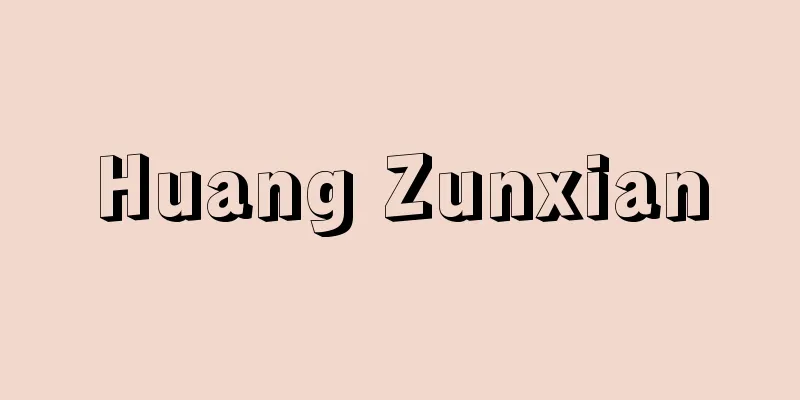Huang Zunxian

|
A Chinese diplomat and poet in the late Qing dynasty. His pen name was Gongdu, and his pen names included Donghai Gong and Master of Faji Shangrenzhai. He was born in Jiaying Prefecture (Meixian, Guangdong Province) to the Hakka (a group of Han Chinese with a unique dialect). In 1876 (the second year of the Guangxu era), he passed the exam to become a judge, and the following year accompanied the first Japanese envoy to Japan, He Ruzhang, to Japan, where he began his career as a diplomat. After that, he worked for nearly 20 years in San Francisco, London, and Singapore, broadening his horizons abroad, and after returning to China in 1894, he formed friendships with reformists such as Liang Qichao, and supported the Restoration Movement, centered on the establishment of a constitutional monarchy. He excelled in poetry from an early age, and his realistic works that sing of the turbulent times at the end of the Qing Dynasty are called "Poetry History," and his "New School Poetry," which incorporates slang and new ideas into traditional forms, became the forerunner of the later literary revolution, and he is regarded as a leader in the "poetry revolution." His works include "Nihon Miscellaneous Poems" in two volumes, "Nihonkokushi" in 40 volumes, and "Jinkyoro Shiso" in 11 volumes. [Sato Tamotsu] "Selections of Chinese Poets, Volume 2, 15, Huang Zunxian, annotated by Shimada Kumiko (1963, Iwanami Shoten)" ▽ "Okawachi Documents, edited and translated by Sanetou Keishu (1964, Heibonsha, Toyo Bunko)" ▽ "Japanese Miscellaneous Poems, translated by Sanefuji Yoshihide and Toyoda Jo (1968, Heibonsha, Toyo Bunko)" Source: Shogakukan Encyclopedia Nipponica About Encyclopedia Nipponica Information | Legend |
|
中国、清(しん)末の外交官、詩人。字(あざな)は公度(こうど)、号は東海公、法時尚任斎(ほうじしょうじんさい)主人など。嘉応(かおう)州(広東(カントン)省梅県)の客家(ハッカ)(特殊な方言をもつ漢人の一群)の出身。1876年(光緒2)挙人に合格、翌年初代駐日公使何如璋(かじょしょう)に随行して来日、外交官生活に入った。以後、サンフランシスコ、ロンドン、シンガポールで20年近く活躍して海外の見聞を広め、94年帰国後梁啓超(りょうけいちょう)ら改良派の人々と親交を結び、立憲君主制の樹立を中心とする維新運動を援助した。早くから詩に優れ、清末動乱の世相をうたう現実的な作品は「詩史」といわれ、伝統形式のなかに俗語や新事物を詠み込んだ「新派詩」は後の文学革命の先駆となり、「詩界革命」の第一人者と評されている。『日本雑事詩』2巻、『日本国志』40巻、『人境廬詩草(じんきょうろしそう)』11巻がある。 [佐藤 保] 『島田久美子注『中国詩人選集2集15 黄遵憲』(1963・岩波書店)』▽『さねとう・けいしゅう編・訳『大河内文書』(1964・平凡社・東洋文庫)』▽『実藤恵秀・豊田穣訳『日本雑事詩』(1968・平凡社・東洋文庫)』 出典 小学館 日本大百科全書(ニッポニカ)日本大百科全書(ニッポニカ)について 情報 | 凡例 |
<<: Hwang Sun-won (English spelling)
>>: Tristellateia australasica R.Rich.
Recommend
Attack on Kishu - Kishuzeme
...The Negoro and Saika groups are also famous as...
caloric
...Therefore, if we are to make the law of conser...
Académie des Beaux-Arts (English)
...among them, the Academy of Vienna (1692) and t...
Isho Tokugan - Isho Tokugan
A Rinzai sect monk from the mid-Muromachi period ...
Kingdonia uniflora (English spelling)
…It is generally considered to be close to the Ra...
Two geniuses from Gyumon
…He moved to Tokyo to pursue a literary career ra...
Amir Khusrō
1253‐1325 An Indian Persian poet. Known as the &qu...
Coastal forces and coastline development - Coastal forces and coastline development
…He became a professor at Columbia University in ...
Tang Wen Cui (English spelling)
An anthology of poetry and prose from the Tang dyn...
sacrae largegitiones (English notation) sacraelargitiones
…The finances of the late Roman Empire were admin...
Grace - charis; gratia; grace
Grace, grace, or favor. A fundamental concept in C...
Adrian, ED - Adrian
…The area of each area is particularly large in...
Consus (English spelling)
An ancient Roman god. He was the patron deity of g...
Stemona tuberosa (English name) Stemonatuberosa
…[Tetsuichi Yahara]. … *Some of the terminology t...
Mikabu green rocks
Green rocks that make up the main part of the Mik...









